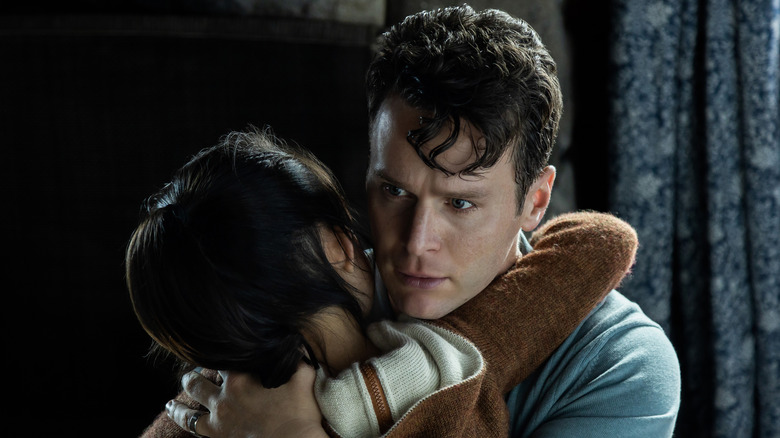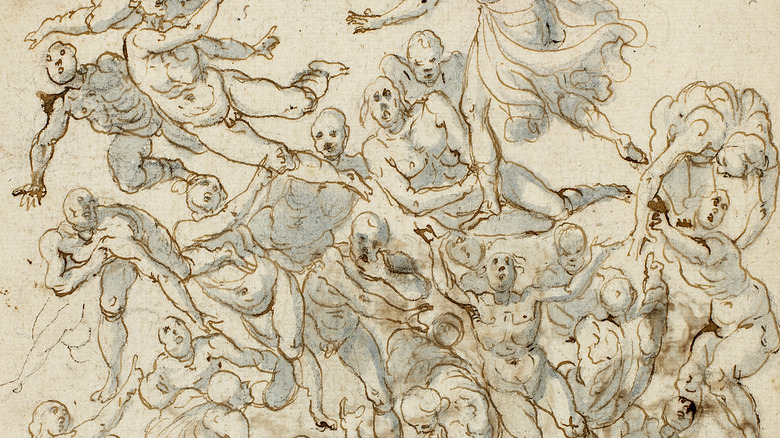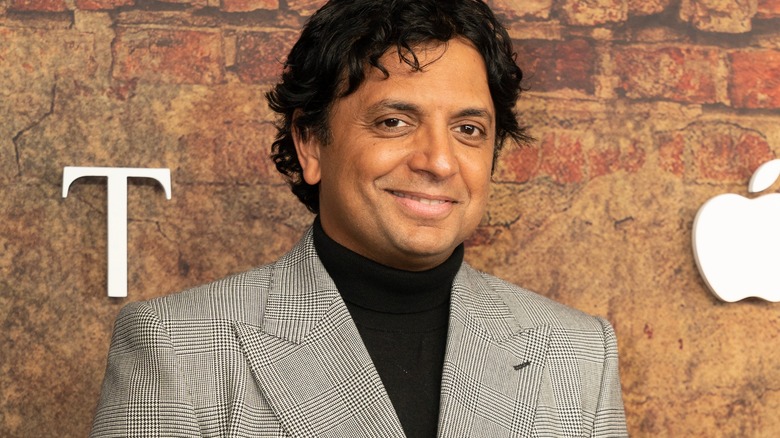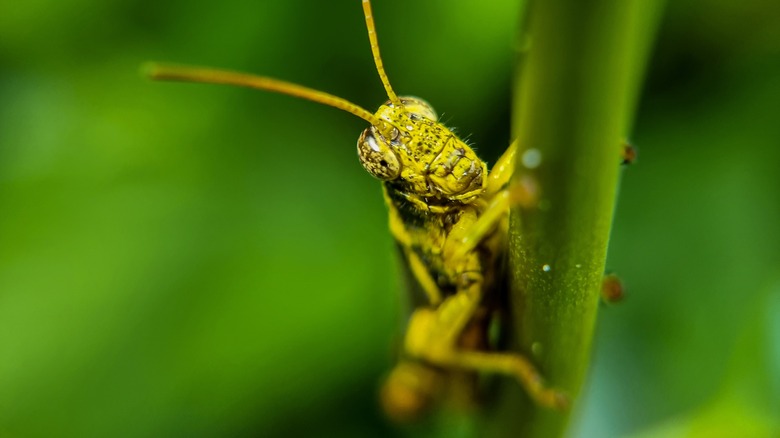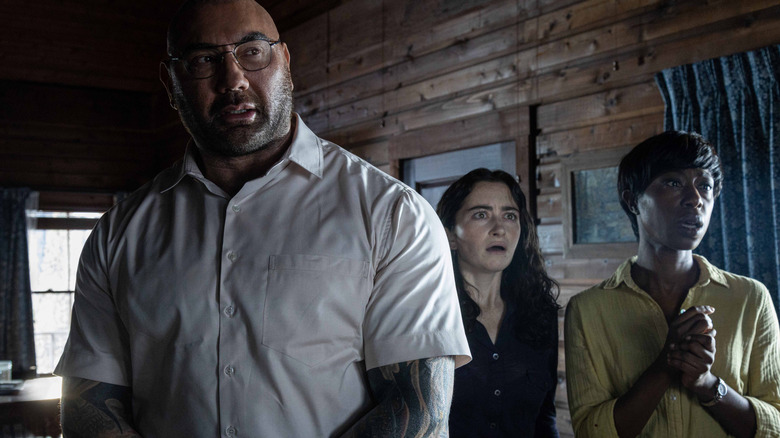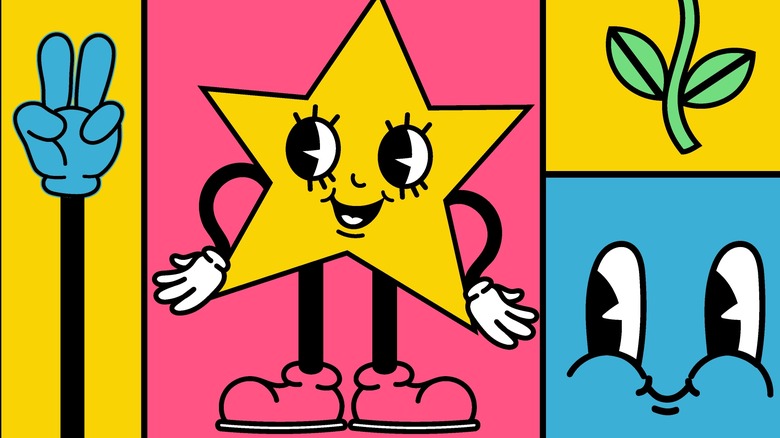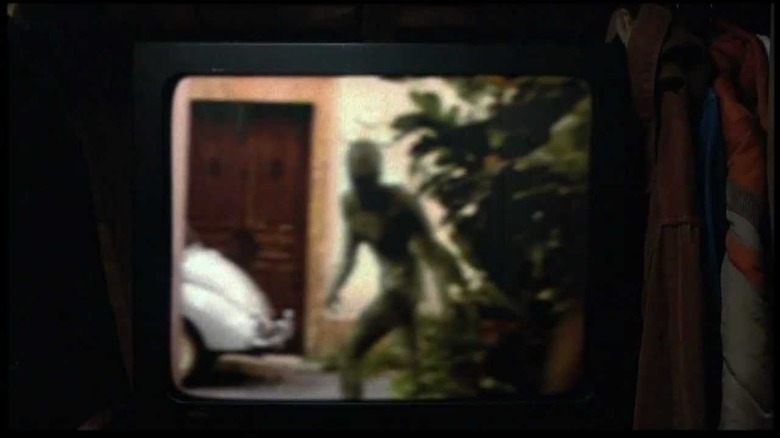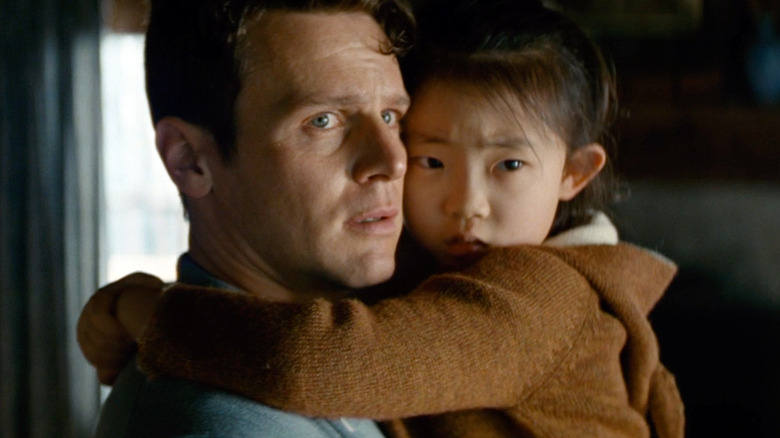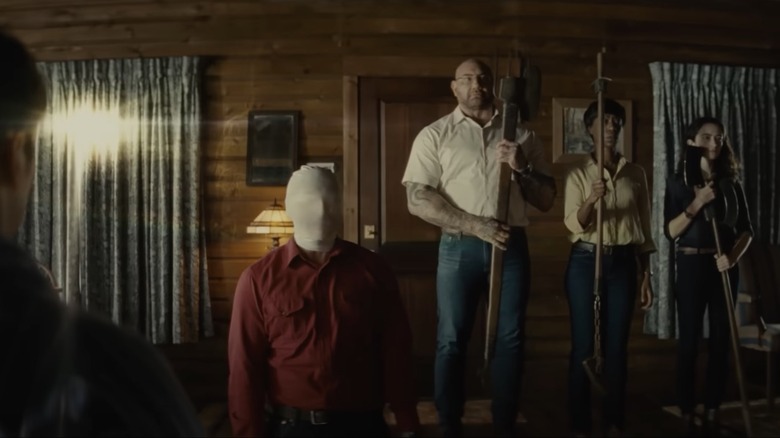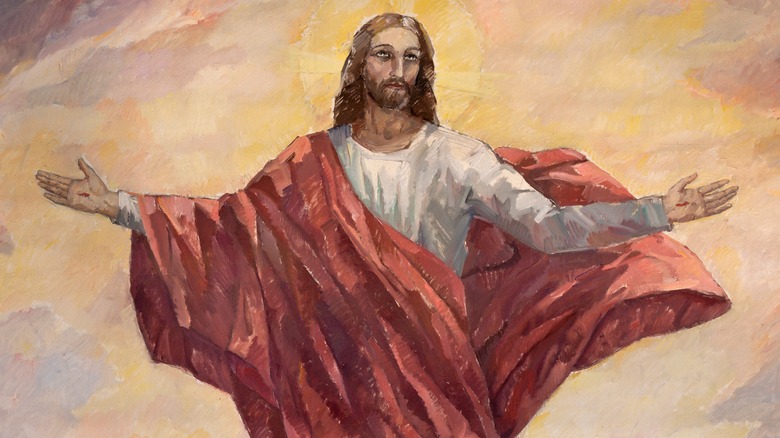Small Details You Missed In Knock At The Cabin
M. Night Shyamalan's "Knock at the Cabin" is an intense home-invasion horror-thriller that, in the eyes of many, marks a return to form for the filmmaker. Based on the best-selling novel "The Cabin at the End of the World" by Paul G. Tremblay, the film version stars Ben Aldridge ("Spoiler Alert") and Jonathan Groff ("Matrix: Resurrections") as a loving gay couple who, with their adopted daughter Wen (newcomer Kristen Cui), visit a remote cabin for a fun, relaxing vacation. Things go sideways when four strangers — played by Dave Bautista ("Guardians of the Galaxy"), Rupert Grint (the "Harry Potter" series), Nikki Amuka-Bird ("Old"), and Abby Quinn ("Black Mirror") — interrupt their vacation and invade the cabin, taking the family hostage. To be fair, they do knock politely first (hence, the title).
The strangers then proceed to tell the family that they must willingly sacrifice a loved one — who has to willingly accept the sacrifice — to prevent an apocalypse that will wipe out all of mankind. Skeptical at first, the more evidence stacks up, the more it becomes unclear what's true and what's a lie — and if it is true, would they actually be willing to make the ultimate sacrifice?
Like any good Shyamalan film, there are ample twists-and-turns throughout. Below are some seemingly minor details that hints at the film's big reveals; read on only if you're prepared for a (spoiler-heavy) stab at the "Cabin."
Opening credits shows visions
The opening credits for "Cabin" commence with a viscerally creepy bang. Right after the Universal logo fades away, the audience is treated to a quick-cut montage of increasingly disturbing, horrific pen drawings of monsters, corpses, blood and destruction, scribbled all over things like medical forms, legal documents and children's report cards. It's evocative of the opening credits of 1995's "Se7en" — which makes sense, as Shyamalan has gone on record saying he wanted "Cabin" to have the vibe of a '90s horror-thriller, even filming with lenses from the period.
Eventually, it is revealed that the drawings are visual depictions of various, seemingly prophetic and apocalyptic visions of the four strangers (Bautista's Leonard, Amuka-Bird's Sabrina, Grint's Redmond and Quinn's Ardiane).
The official documents that seem to largely serve as canvases for these scribbles implies that — even though later in the film Aldridge's Andrew claims that all of the visitors are having a shared delusion — something deeper, perhaps even supernatural is going on. Since Sabrina's a nurse, it's medical records; Leonard, a teacher, is the source of the report cards; Ardiane has kiddie drawings, from her son.
Taken as a whole, the drawings predict events that will unfold later in the film — from an emaciated corpse to plane explosions.
Shyamalan makes a cameo during the cooking informercial
Shyamalan has multiple signatures he attempts to add in the majority of his films — for better, or for worse. This includes his use of narrative twists, his thematic utilization of color, and, of course, the Hitchcockian cameos which sometimes even become more like supporting work.
Shyamalan is on camera again in "Cabin," this time as an overly-excited product pitchman for a satirically-lame product on a fake QVC-esque informercial. The program goes on for a little bit, with the family forced to watch it, when a special "Breaking News" report interrupts the filmmaker's pitchman performance to show footage of the first plague to impact the Earth, as fifty-foot tidal waves slam into unsuspecting civilians.
M. Night's cameo in "A Knock at the Cabin" is actually quite a bit sneakier than a lot of his other on-screen appearances in his own films; this time around, he is never really focused on, with his entire performance only shown in the background on a TV.
Grasshopper allegory to the situation
After the opening credits, the film cuts to a young girl named Wen (Kristen Cui) sitting in an open field, attempting to put grasshoppers into a jar with a hole-poked lid on top. Afterwards, she uses colored pencils to write cute notes and statistics about the various grasshoppers, which she even assigns names.
Not long after, the film introduces Bautista's burly but sensitive character, who approaches the lone Wen. Despite some initial hesitation in speaking with a stranger, she has a conversation with Leonard where he reveals he too enjoys capturing grasshoppers. He urges her to be gentle, so as not to spook them, foreshadowing what's to come.
Essentially, all four of the strangers with prophetic visions — of which Leonard is one — will trap the family in their cabin and try their best to keep the hostages calm as they consider sacrificing one of their own. Obviously, this doesn't go well — how could it? — but the attempt is made nonetheless. These efforts at gentle enclosure include attending to their medical needs, keeping Wen safe, and giving their backstories to help humanize themselves. The cabin itself is an allegory for the grasshopper jar — as they enter, there is no chance for escape.
Tilted angles showcases Leonard's dilemma
When Leonard first appears, talking to Wen, the camera begins acting unsettlingly off-balance, tilting further as the conversation progresses. Known as a "dutch angle" among cinematographers, TV Tropes says the effect is employed "to help create a jarring, 'off-center' feel... Done well, it can create an eerie setting that isn't quite right."
Shyamalan uses the technique repeatedly to portray Leonard's torn psychological state. The man has a task he doesn't want to do, which involves him killing, torturing, and carrying the burden of the fate of the entire world on his mind. Everything in his worldview is thus "off-center" and "not quite right."
The use of the "dutch angle" is also in keeping with Shyamalan's '90s thriller theme. "[It] was a particularly popular technique in the 1990s, where (especially in advertising) it was essentially the 20th-century counterpart to Jitter Cam," says TV Tropes. Classic '90s films that crafted an off-kilter feel with dutch angles include Terry Gilliam's "12 Monkeys," Brian De Palma's "Mission Impossible," Steven Spielberg's "Hook" and... well, pretty much the entirety of Jeunet/Caro's "Delicatessen" and "The City of Lost Children."
Cartoon TV show allegory for learning empathy
After the four strangers-with-visions invade the cabin and tie up Andrew and Eric while keeping an eye on Wen, the flat screen TV shows a colorful, animated cartoon — presumably something Wen was watching before going to catch grasshoppers earlier that day. Afterwards, Leonard attempts to keep things as light and stress-free as possible, saying the show looks fun and educational. He then adds that, like a lot of children's entertainment, the show seems determined to instill in kids a sense of empathy and understanding.
Afterwards, Leonard leads the other strangers to open up about their pasts, their jobs, their hopes and dreams. The point of this, as Eric later says, is to give the family empathy for humanity as a whole, since the people sent to the cabin all represented important aspects of it (educators, healers, mothers, and those seeking redemption).
Essentially, the family in the film have to make the ultimate sacrifice to save the world... but that sacrifice can't be made in a vacuum. They have to be reminded that if they damn the world, they'll be essentially damning people just like themselves — with families, dreams, and love in their hearts. It's easy for people to be less empathetic when they are shielded or distanced from the suffering of others, but learning to empathize with humanity — whether through a children's show, or through learning about people's lives — is imperative.
News report segment reminiscent of Signs
News reports are frequently used in many types of films, and Shyamalan has used his share. It's a great way to dole out a lot of exposition in a short amount of time, which is great for genre films eager to get backstory out of the way as quickly as possible and get to the more interesting aspects, such as the character drama or twisty narrative.
Shyamalan has a unique place in this particular cinematic corner, however, having created one of the best — if not, at least one of the most memorable — fake news reports in film history.
In 2003's "Signs," the main family of characters (played by Mel Gibson, Joaquin Phoenix, Rory Culkin, and Abigail Breslin) are stuck in their Pennsylvania home, watching a news report of camcorder footage at a Brazilian birthday. After much of the film seeming offbeat but somewhat grounded in the everyday, the blurry footage suddenly debuts what looks to be a green-skinned, humanoid alien. Despite what the aliens — hampered by early-2000's CGI — look like later in the film, the scene remains a shocking kick in the teeth.
The news report scenes in "Knock at the Cabin" — particularly the plague of fifty-foot tidal waves — is filmed in a similar way to "Signs." In both films, the cameraman is filming people having fun, before finding themselves confronted with something beyond their comprehension. So, it seems relatively conceivable that Shyamalan fell back on one of his earlier hits; since both films deal with themes of faith, spirituality, and re-discovering them through premonition and tragedy, the relationship feels apt.
Boogie Shoes song lyrics represents Eric's spiritual journey
While "Cabin" is mostly a self-contained thriller, there are moments where flashbacks depict the lives of Eric, Andrew, and Wen before the home invasion. One such flashback includes the family happily singing along to the 1975 classic "Boogie Shoes" by KC and The Sunshine Band.
By the end of the film, after Eric sacrifices himself, a reappraisal of the song works as a profession of love for his family, especially Wen, and how much he wants to be together forever; the lyric sing, "Girl, to be with you is my favorite thing, yeah... And I can't wait til I see you again."
That last part gains new resonance in the film as the characters are convinced of God's existence. This means when the song says, "and I can't wait til I see you again," he's literally talking about meeting her in heaven. She's also the reason he makes the sacrifice in the first place.
Then there's the lyric "I want to do it 'til the sun comes up...," symbolizing that Eric's ultimate sacrifice will "bring the sun up." After Andrew is forced to willingly sacrifice his husband Eric, the dark clouds that were forming due to the onset of the apocalypse fade away and let literal sunlight back in. Later, Wen and Andrew see that the plagues that had been destroying humanity have receded.
"Boogie Shoes" is the last song viewers hear Wen and Andrew listening to at the end of the film; it's Eric attempting to reach out to them metaphorically (or perhaps literally, given the spiritual nature of the film).
The cult's voices and mannerisms change before killing
One of the most powerful aspects of "Knock at the Cabin" is its all-encompassing mystery of "is it real?"
Are the strangers who invaded the cabin truly getting horrific visions of the end times... or are they lying to gaslight the family into harming each other, as punishment for being a gay couple raising an immigrant child? Are these strangers living a shared delusion based on a deranged echo chamber of internet misinformation? Or could they be correct?
One early clue that the film uses to substantiate the validity of their visions and prophesies, as well as the divine will of a vengeful God, is when they kill their first acolyte — Grint's violent, homophobic Redmond. After the family refuses to sacrifice one of their own, Redmond gets on his knees and puts a mask over his head, the other strangers getting their makeshift weapons ready to ritualistically kill him.
While this is happening, the viewer can see how robotic and cold they get while performing this sacrificial ritual, with each speaking some ancient prayer in unison. Even Redmond, who was initially frightened, seems calm right before his death. When the deed is done, the surviving invaders become disoriented, perturbed, and sick — with Bautista's Leonard even vomiting in the sink. This seems to indicate that once they say, "humanity is judged," they are being spoken through by (for lack of a better term) "the voice of God," and that they aren't in control.
This is seemingly confirmed later in the film, as Eric states he saw a glowing figure right before Redmond was executed.
The Jesus painting in China foreshadows Eric's decision
One of the biggest conflicts of the film's story comes via messages of "faith and sacrifice" vs. "skepticism and selfishness."
Throughout the film, Andrew's distrust and anger has led to a worldview based on cynicism and mistrust. The film shows him not being surprised that his parents were unsupportive of him moving in with husband Eric, his aggressive behavior towards the homophobic Redmond, and his belief that screwing over the world is worth it to save his family.
Although it's never fully stated in the film that there's a divide in the relationship between Andrew's atheism vs. Eric's religiosity, it nonetheless seems like a clear implication. There is a scene at a Chinese adoption agency where Eric and Andrew are waiting to pick up Wen. While in the waiting room, they both spot a painting of a Chinese Jesus playing soccer with some kids. Afterwards, Andrew turns to Eric, saying he can pray to him if he wants. But Eric doesn't pray, however, and the comment is played off as a joke.
Later in the film, Eric is the one who first starts believing in the strangers' prophesies, and ultimately he is the one who decides to sacrifice himself to give Wen a life that won't involve roaming a raptured wasteland. His faith gave him the clarity to see through the fear of death, seeing the truth of God's will.
